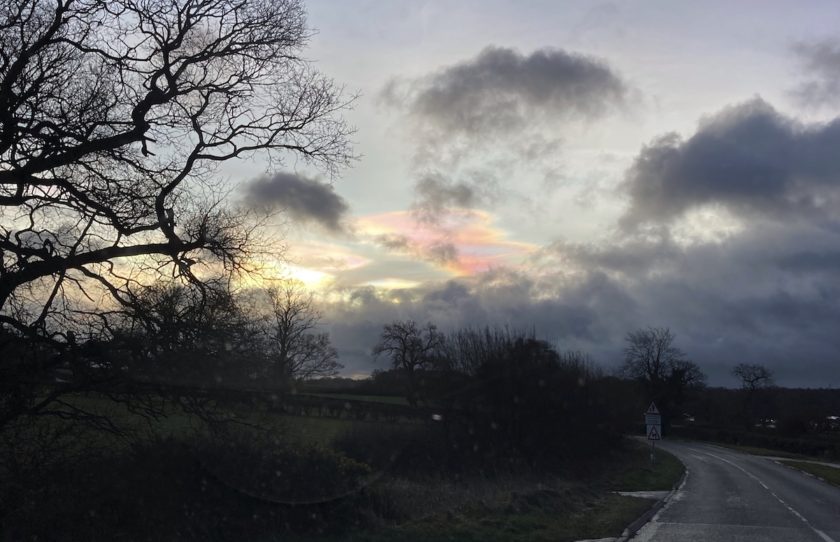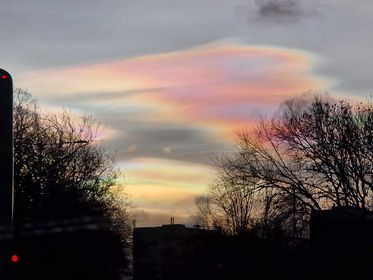Very rare ‘mother of pearl’ Nacreous clouds spotted above Flintshire

Residents of Flintshire have been treated to an extraordinary natural spectacle today as rare Nacreous clouds, often referred to as ‘Mother-of-Pearl’ clouds, adorned the sky.
Captured in a photograph sent by local resident Vicky Woods to Deeside.com, this rare phenomenon was spotted Vicky and her daughter, on their morning journey to school in Northop Hall.

Jenny sent us the picture above taken in Flint on Thursday morning.
Social media has been buzzing with pictures of these stunning clouds, with posts from across the UK showcasing their remarkable colours.
Nacreous clouds out again over Edinburgh this morning just before sunrise – these beautiful iridescent mother-of-pearl clouds form at 70 to 100 thousand ft above Earth at temperatures below minus 78°C#Nacreous #Edinburgh #Scotland #Polwarth pic.twitter.com/QlSCtWLjnA
— Tom Duffin Photographer (weePhotos) (@TomDuffinPhotos) December 21, 2023
The nacreous / polar stratospheric clouds are still visible from North Yorkshire. This shot taken at 12.05pm. They’ve faded a bit now but are still visible. #StormHour #Weather #NacreousClouds #PolarStratosphericClouds pic.twitter.com/hRuCUTcNFQ
— Steve ‘Sirius’ Brown – amateur astronomer 🔭📷✨🌙 (@sjb_astro) December 21, 2023
Nacreous clouds, typically developing above the polar regions, have been spotted across Scotland and England this week!
The effect, which resembles mother of pearl, is produced as the sunlight diffracts around the tiny ice crystals inside them.https://t.co/B6ZaJQKQLX pic.twitter.com/ZCfbM9Y9xB
— Royal Meteorological Society (@RMetS) December 21, 2023
Nacreous clouds are a rare meteorological phenomenon that occurs at extremely high altitudes, typically between 68,500 and 100,000 feet.
These large, thin discs in the sky are known for reflecting vivid colors, similar to those seen on a thin layer of oil on water, an effect known as iridescence.
They do not produce precipitation and are formed of ice particles that scatter light in unique ways, creating their distinctive luminous appearance.
These clouds form in the lower stratosphere over polar regions and become visible when the Sun is just below the horizon.
Due to their high altitude and Earth’s curvature, these clouds are illuminated from below, shining brightly in the twilight hours.
Most commonly seen in higher latitude regions like Scandinavia and northern Canada, they are sometimes referred to as polar stratospheric clouds. T
he formation of Nacreous clouds is contingent on temperatures below -78 °C, typically occurring during the polar winter.
In the UK, sightings of Nacreous clouds are rare and usually happen when the cold air of the stratospheric polar vortex, which typically circulates around polar regions, is displaced over the UK. These clouds are mostly associated with very cold and dry weather conditions.
Nacreous clouds are categorized into three types – Ia, Ib, and II – based on their chemical composition, height, and the ambient temperature at which they form.
The sighting of these clouds over Flintshire is a rare and captivating event, offering a glimpse into the complex and beautiful interactions between our planet’s atmosphere and weather patterns.
Residents and nature enthusiasts across the UK have been marveling at this ethereal display, a reminder of the awe-inspiring phenomena that the natural world has to offer.
Spotted something? Got a story? Send a Facebook Message | A direct message on Twitter | Email: [email protected] Latest News









